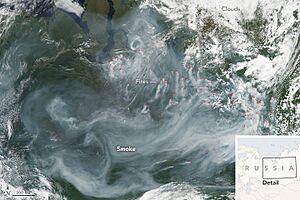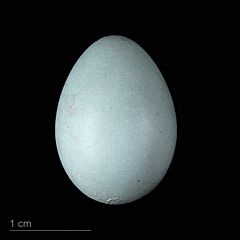Siberian accentor facts for kids
Quick facts for kids Siberian accentor |
|
|---|---|
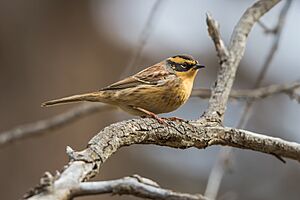 |
|
| Conservation status | |
| Scientific classification | |
| Genus: |
Prunella
|
| Species: |
montanella
|
 |
|
|
Breeding summer visitor
(ranges are very approximate)Winter visitor |
|
The Siberian accentor (Prunella montanella) is a small passerine bird. It lives in northern Russia, across Siberia. These birds are migratory. They fly to Korea and eastern China for winter. Sometimes, they are seen in western Europe and North America.
Siberian accentors like subarctic forests. They often live near water. You can also find them in mountains and spruce forests. In winter, they stay in bushes and shrubs. They might also be in dry grasslands or woods.
This bird has brown upper parts and wings. Its back has bright chestnut streaks. The tail is greyish-brown. Its head has a dark brown top. It also has a long, pale yellow "eyebrow" (called a supercilium). All Siberian accentors look quite similar.
Females build open cup-shaped nests. They lay four to six shiny blue-green eggs. The eggs hatch in about ten days. Adult birds and chicks eat mostly insects. They usually find food on the ground. In winter, they might eat seeds. They can also feed near people.
The Siberian accentor lives over a very large area. Its population is big and stable. So, it is listed as a species of least concern. This means it is not currently in danger. However, climate change might affect it in the future. In 2016, many of these birds flew to western Europe. This was very unusual.
Contents
What is a Siberian Accentor?
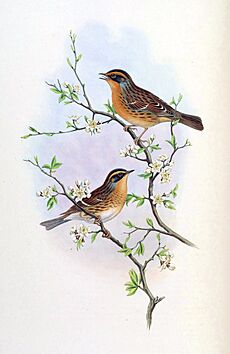
Siberian accentors are small birds. They are about 14.5 centimeters (5.7 inches) long. They weigh around 17.5 grams (0.6 ounces). The adult bird has brown upper parts and wings. Its back has bright chestnut streaks. The rump and tail are greyish-brown. It has two thin white bars on its folded wings.
Its head has a dark brown crown. There is a long, wide pale yellow stripe above its eye. This is called a supercilium. It also has a blackish patch behind its eye. The sides of its neck are grey. Its belly is yellowish. The sides of its body are buff-colored. There are rich chestnut streaks on its chest and sides.
The bird's eye is reddish-brown. Its beak is dark and pointed. Its legs are reddish. Male and female birds look very similar. Females have slightly duller colors. Young birds are also duller. They have brown spots on their chest.
There are two types, or subspecies, of Siberian accentors:
- Prunella montanella montanella: This type lives in northern Russia. It ranges from Europe to the Lena River. It also lives further south, from the Ob to the Amur River.
- Prunella montanella badia: This type lives in northeastern Siberia. It ranges from the Lena River eastwards. It also lives south to the Sea of Okhotsk. This type is a bit smaller and darker.
The word "accentor" means "sing with another." The genus name Prunella means "brown." The species name montanella means "mountain."
How Siberian Accentors Sound
The Siberian accentor's call sounds like ti-ti-ti. The male bird sings from a bush or tree. Its song is loud and high. It sounds like chirichiriri. Some say it sounds like the Japanese accentor or the dunnock. Birds sing most when they are breeding. Some also sing during migration.
Where Siberian Accentors Live
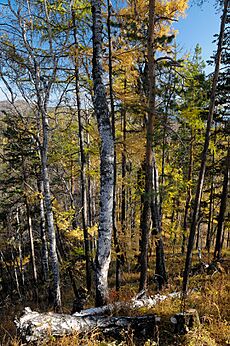
Siberian accentors breed across northern Russia. This area stretches from the Ural Mountains to the Pacific coast. There is also another group in southern Siberia. They are migratory birds. They spend winter in eastern China and Korea. A few also winter in Mongolia. They rarely go to Japan.
They breed in subarctic forests. These include willow and birch trees. They also like open coniferous woodlands. These areas are often near rivers or wet lands. Some live in mountains and spruce taiga forests. In winter, they live in bushes and shrubs. They are often near streams. They can also be found in dry grasslands and woods.
Their Journeys and Travels
Siberian accentors leave their northern breeding areas in mid-September. They might stay longer in the south. In spring, they fly back. They pass through Mongolia in late March. They reach southeastern Russia in April and May. They arrive at their breeding grounds in May or June.
Some birds have been seen in unusual places. These include Belarus, Kazakhstan, and many European countries. They have also been seen in North America. Most North American sightings are in western Alaska and British Columbia. A few have been seen in Alberta, Idaho, and Montana.
The Big Trip of 2016
In October and November 2016, many Siberian accentors flew to western Europe. This was very unusual. It was the first time they were seen in Estonia, Germany, the Netherlands, and the UK. Many bird watchers came to see them.
Before 2015, only 32 birds had been seen in western Europe. But in 2016, at least 231 were reported. They were seen in many countries. Most of these birds were young, in their first winter. One bird stayed in Scotland until February 2017.
Many birds were found on coasts and islands. Strong easterly winds from Siberia likely pushed them west. These winds were caused by a high-pressure area over Scandinavia. Other weather systems also caused easterly winds.
The same weather brought other Siberian birds to Europe. This included many yellow-browed warblers. It also brought rare birds like the pale-legged leaf warbler. Forest fires in Siberia that summer might also have played a role. Birds might have flown west to avoid the smoke.
Behavior and Life Cycle
Siberian accentors are shy birds. They quickly hide in bushes. They are good at staying warm in cold weather. This helps them live in their cold homes.
Reproduction
The breeding season is from June to August. Not much is known about their breeding habits. Some groups of nests are found close together. This is common for the northern type of accentor.
The nest is an open cup. It is built in a dense shrub or tree. Nests are usually 0.4 to 8 meters (1.3 to 26 feet) above the ground. They are made of twigs and leaves. The inside is lined with hair or fine grasses. The eggs are shiny deep blue-green. They are about 18.6 x 13.7 millimeters (0.73 x 0.54 inches). Each egg weighs about 1.9 grams (0.07 ounces).
The female sits on the eggs for about ten days. She incubates four to six eggs. Both parents feed the chicks. The chicks are brown-black and downy. They can breed themselves the next year. Birds in the south might have two sets of chicks a year. Those in the north usually have only one.
Feeding Habits
Siberian accentors mostly eat insects. They usually pick them off the ground. They also find insects on plants and trees. They often look for food near snow fields. Young birds are fed mainly insects. They especially like beetle larvae. Parents bring several food items to the nest at once.
In winter, they might eat seeds. They can also feed near people. They eat seeds from plants like crowberry and bistort. They also eat seeds from the amaranth and birch families.
Conservation Status
We don't know the exact number of Siberian accentors. But the population is large and stable. Their breeding area is about 2.2 million square kilometers (0.85 million square miles). Because of this, the IUCN lists them as a species of least concern. This means they are not currently at risk.
However, they breed in northern areas. So, climate change could affect them in the long run. In some parts of Russia, there are over 30 pairs per square kilometer. In other areas, it's around 5 pairs per square kilometer. The weather can also affect how many birds are in an area.
Siberian accentors can carry the taiga tick. This tick can carry bacteria. These bacteria cause Lyme disease.





